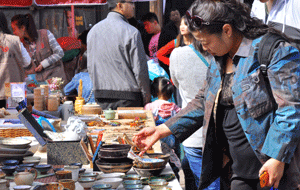Chinatown told through photos of peoples' rooms
Updated: 2014-12-02 11:33
By Amy He in New York(China Daily USA)
|
||||||||
|
A room that Chinese-American photographer Louis Chan documented for his photo series My Home, which shows the inner spaces of 12 Chinese-American homes in Manhattan's Chinatown. Provided to China Daily |
There are pig trinkets, pig-shaped mugs and pig figurines bursting from shelves. Stuffed pig dolls are strewn across a bed.
The room overflowing with pig toys belonged to a girl living in an apartment in Manhattan's Chinatown. Another room at the apartment has a dry-erase board that exclaims, "You can do it!"
Underneath is a "how to get rich plan", whose goals include saving 10 percent of each paycheck, figuring out a reliable business to open, and planning a workout schedule.
The rooms were photographed by Chinese-American photographer Louis Chan for a series called My Home, which showcases the rooms and homes of 12 Chinese-American families in Chinatown.
Chan's series, which was on display at the University of Tennessee gallery in November, was the 33-year-old's attempt at documenting his Chinese-American identity by finding the common thread in the immigrant experience.
Another room in the series was plastered with pullouts from Chinese calendars, which often feature celebrities and are given free to customers at year-end at many grocery stores and supermarkets.
"The project touches on so many things, and one of them is obviously personal possessions," Chan told China Daily. "There are so many similarities that we take for granted. We're obviously from different families, but because of our culture and our location and our upbringing, all these little social cues are so similar."
Chan, a staff photographer at the Borough of Manhattan Community College, began photographing homes in 2011 because he was fascinated by New York City's Housing Authority buildings, otherwise known as "projects" in the city.
Chan grew up in the projects to immigrant parents from southern China and would often catch glimpses of the insides of other apartments in his building. When he began his project in earnest, he wanted to document all kinds of homes, not just those of Chinese Americans. Once he started asking his friends and family members to let him inside their apartments, it made more sense to him to document homes that he knew and had already seen.
"I can photograph personal possessions of anybody - you can get that from anyone going into their space - but personal relationships work a lot better in my photographs," said the native New Yorker.
"There was just something that was more interesting to me when it came to friends and family. It was not a coincidence that they were all Chinese American. For me, it started becoming interesting research on my own identity."
Through photographing and looking at the kinds of spaces the families lived in, Chan believed that the Chinese immigrant experience was in some ways about not assimilating as much as it was about blending in, he said.
The close-knit nature of the community meant that families were buying a lot of the same things, using a lot of the same products, and living very similar Chinese lifestyles, Chan said.
"I would say that Chinese people tend to not assimilate as much as others," he said. "But then, that opens up a whole new topic of, is it because of racism and discrimination that they have to close themselves within their own community, or is it some cultural thing where they just don't assimilate? I don't have the answer to that."
There is also a sense that the Chinese community may be a little old-fashioned, he said.
amyhe@chinadailyusa.com

 US jeweler goes after China's love of diamonds
US jeweler goes after China's love of diamonds
 US Treasury 'Lucky Money' Honors Year of the Goat
US Treasury 'Lucky Money' Honors Year of the Goat
 China-US Internet Forum in DC
China-US Internet Forum in DC
 World AIDS Day marked around the world
World AIDS Day marked around the world
 Chinatown told through photos of peoples' rooms
Chinatown told through photos of peoples' rooms
 Creative products by Palace Museum
Creative products by Palace Museum
 Group wedding before setting sail
Group wedding before setting sail
 Guangzhou zoo is home to five generations of koalas
Guangzhou zoo is home to five generations of koalas
Most Viewed
Editor's Picks

|

|

|

|

|

|
Today's Top News
Database to track Chinese fugitives overseas
Foreign firms set for tougher tax scrutiny in China
China's Wanda Group in talks to buy Lions Gate stake
China-US Internet Forum in DC
Sanya resort unveils Tesla charging stations
Using the present to preserve the past
Chinese investors helping build major US road link
Chinatown told through photos of peoples' rooms
US Weekly

|

|








